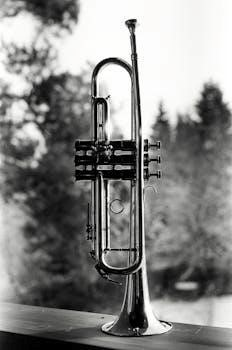Trumpet valve guides are small, but essential components within a trumpet’s valve system. These parts ensure proper alignment of the valves, facilitating smooth and precise operation. They play a vital role in the instrument’s overall performance and longevity.
What is a Trumpet Valve Guide?
A trumpet valve guide is a small, often overlooked, but critical component found within the valve casing of a trumpet. It is designed to fit around the trumpet piston, ensuring that the valve moves up and down in a straight and consistent path. These guides are essential for maintaining proper alignment, preventing the piston from rubbing against the valve casing and causing damage or sticking. Valve guides are typically made from plastic or metal, with each material offering different levels of durability and maintenance needs. They contribute to the smooth action of the trumpet valves and are crucial for the overall playability and performance of the instrument. The design of the valve guide is intended to provide optimal valve movement.

Types of Trumpet Valve Guides
Trumpet valve guides come in different types, primarily plastic and metal. These variations cater to different needs, and instrument specifications. The type of material can impact durability and performance.
Plastic Valve Guides
Plastic valve guides are commonly found in student-level trumpets due to their affordability and ease of replacement. They are lightweight, which can contribute to a smoother valve action for some players. These guides are typically made from nylon or similar polymers, providing a cost-effective solution for basic trumpet maintenance. While they are not as durable as metal options, plastic guides are less likely to cause wear on the brass valve casings. They are also easier to replace, making them a practical choice for beginners or players who require frequent maintenance. However, they can wear down over time, necessitating periodic replacement to ensure smooth valve operation and consistent playability.
Metal Valve Guides
Metal valve guides, often made from brass or titanium, offer enhanced durability and longevity compared to plastic alternatives. These guides are typically found in professional-grade trumpets or used as aftermarket upgrades. Brass valve guides provide a traditional feel and contribute to the instrument’s overall tone, while titanium options offer superior corrosion resistance and exceptional durability. Metal guides are less prone to wear and deformation, ensuring a consistent valve alignment and smooth operation over extended periods. However, metal guides can be more expensive and, in some cases, may cause wear to the brass valve casings if not properly maintained. They are a popular choice for experienced players seeking reliability and performance.

Materials Used in Trumpet Valve Guides
Trumpet valve guides are crafted from various materials, each with unique properties. Common choices include plastic, brass, and titanium, impacting the guide’s durability, performance, and the instrument’s sound.
Plastic
Plastic valve guides are frequently found in student-level trumpets due to their affordability and ease of replacement. These guides are lightweight and comparatively inexpensive, making them a cost-effective option for manufacturers and players. They are typically made from nylon, which helps prevent wear to the brass barrel slots on the pistons. While plastic guides are not as durable as metal options, their lower cost makes them a practical choice for beginners and those needing frequent replacements. Their material also means they are less likely to cause damage to the trumpet’s valve casings compared to harder materials. However, they can be prone to wear and tear over time, requiring periodic checks and replacements.
Brass
Brass valve guides are another option, often favored by professional players for their durability and tonal qualities. Brass, an alloy of copper and zinc, is a traditional material for brass instruments, known for its workability and resistance to rusting. These guides offer a more robust and lasting alternative to plastic, although they can oxidize and corrode over time. Brass guides are chosen for their contribution to the instrument’s response and sound quality. Some prefer them, noting a difference in feel and sound compared to other materials. However, they may require more maintenance and can be more costly than plastic guides, making them less common in student-level trumpets.
Titanium
Titanium valve guides represent a high-end option, prized for their exceptional durability and corrosion resistance. Unlike brass, titanium maintains its integrity over time, providing long-lasting reliability; This material’s superior resistance to corrosion ensures that valve guides remain in optimal condition, free from potential breakage, making them a premium choice for trumpet players seeking longevity and consistent performance. While titanium guides can be more expensive, their durability and resistance to oxidation make them a cost-effective solution in the long run. However, some may caution against using titanium due to its hardness, suggesting it could be harder than the brass components of the trumpet, potentially leading to wear on other parts.

Function and Importance
Valve guides are crucial for maintaining proper valve alignment, ensuring smooth and precise movement. They prevent wear and tear, contributing to the instrument’s overall performance and longevity for musicians.
Maintaining Valve Alignment
The primary function of trumpet valve guides is to maintain the precise alignment of the valves within their casings. This alignment is absolutely critical for the trumpet to function correctly, as it ensures that the valve pistons move up and down smoothly and without any obstruction. When the valves are not aligned properly, it can lead to sticking, sluggish action, and even prevent the valves from moving at all, significantly impacting a musician’s ability to play. Proper alignment allows the air to flow freely through the instrument, producing the desired notes and tones. Without the valve guides, the valves would be unstable and prone to misalignment, making the trumpet virtually unplayable. Therefore, valve guides play a fundamental role in the overall performance and playability of the trumpet by ensuring that the valves operate correctly.
Ensuring Smooth Operation
Beyond just maintaining alignment, trumpet valve guides are vital for ensuring the smooth operation of the valves. These guides facilitate a consistent, low-friction movement, allowing the valves to move quickly and easily when pressed and released. This smooth action is essential for a trumpet player’s ability to execute complex musical passages and fast note changes. If the valve guides are worn or damaged, the valves can become sticky, slow, or even jammed, leading to inconsistent playing. This can cause frustration for the musician and hinder the overall performance. By minimizing friction and ensuring that the valves move seamlessly within their casings, the valve guides contribute significantly to the responsiveness and playability of the trumpet. This is why well-maintained valve guides are essential for any trumpet player seeking optimal performance.
Issues Related to Valve Guides
Several issues can arise with trumpet valve guides, including stuck or turned valves due to wear, damage or lack of lubrication. These problems can hinder the instrument’s performance and playability.
Stuck or Turned Valves
One common issue with trumpet valve guides is that they can contribute to valves becoming stuck or turned. This often occurs when the guides are worn, damaged, or improperly lubricated. A stuck valve will not move smoothly, if at all, hindering the player’s ability to produce notes. A turned valve, where the guide is misaligned, can create friction, causing similar problems. Lack of use or insufficient valve oil can exacerbate these issues, leading to frustrating playing experiences. Regular maintenance and proper lubrication are crucial to prevent these problems from developing and ensure valves move freely within their casings. The material used in valve guides can also affect their susceptibility to these issues.
Wear and Tear
Trumpet valve guides are subject to wear and tear over time due to the constant movement of the valves. The friction caused by the valves sliding against the guides can gradually degrade the material. This is especially true for plastic guides, which are more susceptible to wear than metal ones. Factors like the quality of the material, playing frequency, and maintenance routines all affect the rate of wear. As guides wear, they lose their precision, which can lead to issues like sticking or turned valves. Regular inspection and timely replacement of worn guides are essential for maintaining the instrument’s performance and preventing further damage to the valve system.

Maintenance and Replacement
Proper maintenance and timely replacement of trumpet valve guides are crucial for optimal performance. Regular checks for damage or wear will help prevent issues. Knowing when to replace them ensures smooth valve action.
Checking for Damage
Regularly inspecting your trumpet’s valve guides is essential for maintaining the instrument’s performance. Look for signs of wear, such as cracks, chips, or deformation, which can impede smooth valve action. Check if the guides are securely in place and not loose or misaligned, as this can cause sticking or turned valves. Also, examine the guides for any buildup of grime or residue, which can create friction. Pay close attention to the contact points between the valve guides and the valve casings, noting any unusual wear patterns. Early detection of damage can prevent more significant problems, ensuring the trumpet’s longevity and playability. If you notice any issues, it’s crucial to address them promptly.
When to Replace Valve Guides
Valve guides should be replaced when they show signs of significant wear, damage, or if they are causing performance issues. If the trumpet valves feel sluggish, sticky, or fail to move smoothly, it’s likely the valve guides are worn. Visible cracks, chips, or deformation of the guides are clear indicators they need replacing. If a valve guide is loose or no longer fits snugly, it’s time for a replacement. Also, consider replacing valve guides if you notice a significant change in the trumpet’s response or if the instrument is not playing as well as it used to. Regular replacement, even without visible damage, can be part of routine maintenance to ensure optimal instrument performance and prevent more serious issues.
